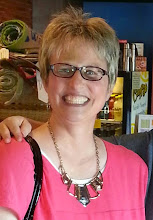.
Science All Around Us - Episode II
(AKA Science Moments With Miss Keetha)
 (photo from www dot cactusjungle dot com)
(photo from www dot cactusjungle dot com)
 (photo from galerrainwater dot com)
(photo from galerrainwater dot com)
Who among us can resist photos of vibrant blooms beaded with morning dew?
Who among us doesn't love to receive a fragrant bouquet of freshly cut flowers, or even a simple nosegay. (Boy, THAT term proves I'm vintage, doesn't it???)
Well, those flowers are all about SEX going on in our gardens!!!!
Flowers are all about sexual reproduction of angiosperms, flower producing plants. Even the color and scent of the flower is designed to attract pollinators. Plants that you don't normally associate with "flowers" may very well have them.
Aside - there are plants which do not use flowers to reproduce, but use cones instead. Those plants are called gymnosperms. Pines, junipers, ginkgos, and cycads belong to that group. Everything else - - - including grass - - - uses flowers to reproduce.
 (diagram from grandpacliff dot com)
(diagram from grandpacliff dot com)
I'm sure we all remember this from our 7th Grade Life Science class - - - but a little refresher course never hurt anyone, and besides, since I'm doing the refreshing and since I LOVE this garden sex - - - I get to choose what to post. :-)
Above is a labeled diagram of a "generic" flower and its parts. This one happens to contain both male and female reproductive parts, as do many flowers. This is not the case with ALL plant species. Some species have separate sexes - - - males and females on separate plants.
Please use the above diagram to find these parts as I talk about them.
The entire male organ in the flower is called the STAMEN. I tell my students that the "men" ending will help them remember that it is the MALE portion. It is made up of a slender supportive stalk called the filament and a "fuzzy" rounded or oblong tip called the anther. The anther is the important part because it produces pollen grains which contain the male gametes, or sex cells, called sperm.
The next time you breathe deeply of a lovely bouquet, and come away with a nose and chin full of pollen, I'm SURE you will be delighted to realize that you now have a face covered in flower sperm. My students LOVE it when I tell them that. But - - - it's true.
The entire female organ in the flower is called the pistil. I HATE it when game show contestants buzz in and say the male flower part is called a pistil. What ARE they thinkin'???? The pistil is shaped like a vase made up of three parts: a sticky widened top called the stigma, a long slender neck called the style, and a broad, rounded base called the ovary. The ovary is the important functioning part as it contains the female gametes, the ova or eggs.
Now for the SEX part. The pollen containing the sperm has to get to the sticky stigma of a pistil. This process is called pollination. Pollination needs a bit of "help" from the outside world since the anther and the stigma are apart from each other. Wind, gravity, insects, humming birds, and even YOU can help with this process. Anything that moves pollen can become a pollinator.
Once the pollen has landed on the sticky stigma, it begins to grow a pollen tube down through the style to the ovary where it connects to an ovum (egg). This pollen tube literally digests away the "flesh" of the style as it grows. The sperm in the pollen grain can then fertilize (unite with) the egg.
Once fertilized, the egg will develop into a seed. The ovary around the developing seeds will mature into a fruit. This means that anything, other than a cone, that contains seeds is biologically a fruit!!!! So, the next time you eat peas, corn, tomatoes, or cucumbers, remember they are FRUITS.
So now you know - - - your beautiful garden is really a sexual hot bed!!!!
Hope you enjoyed these "Moments With Miss Keetha" and that you will tune in again next time, when maybe we'll talk about how you help with seed dispersal, or then again maybe not - - -
.
 I'm ready to go!!! (almost)
I'm ready to go!!! (almost)


















































































